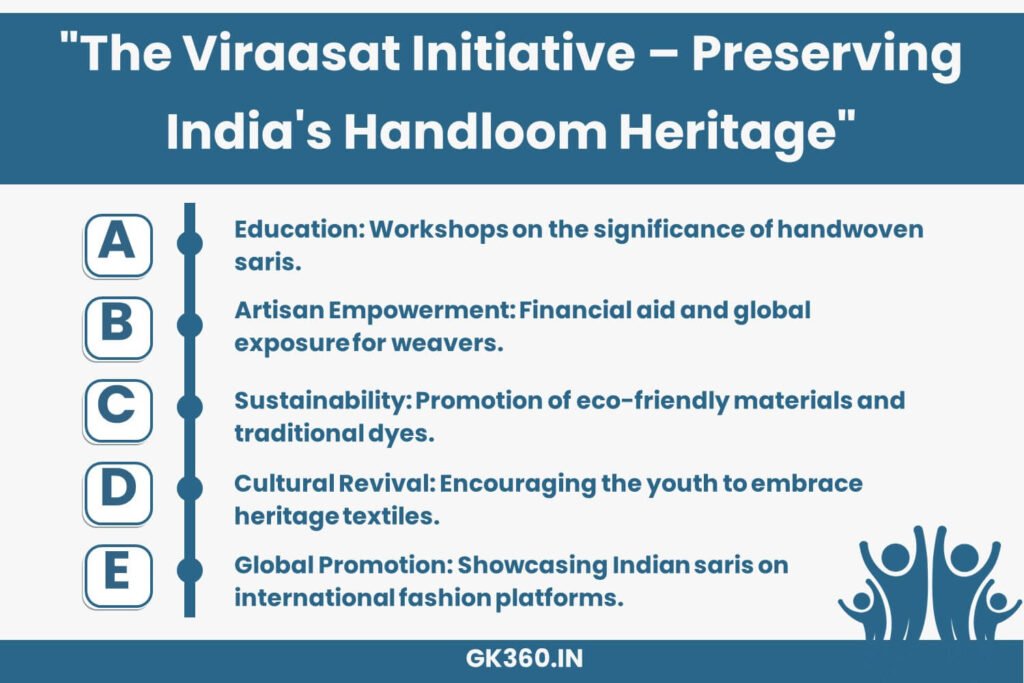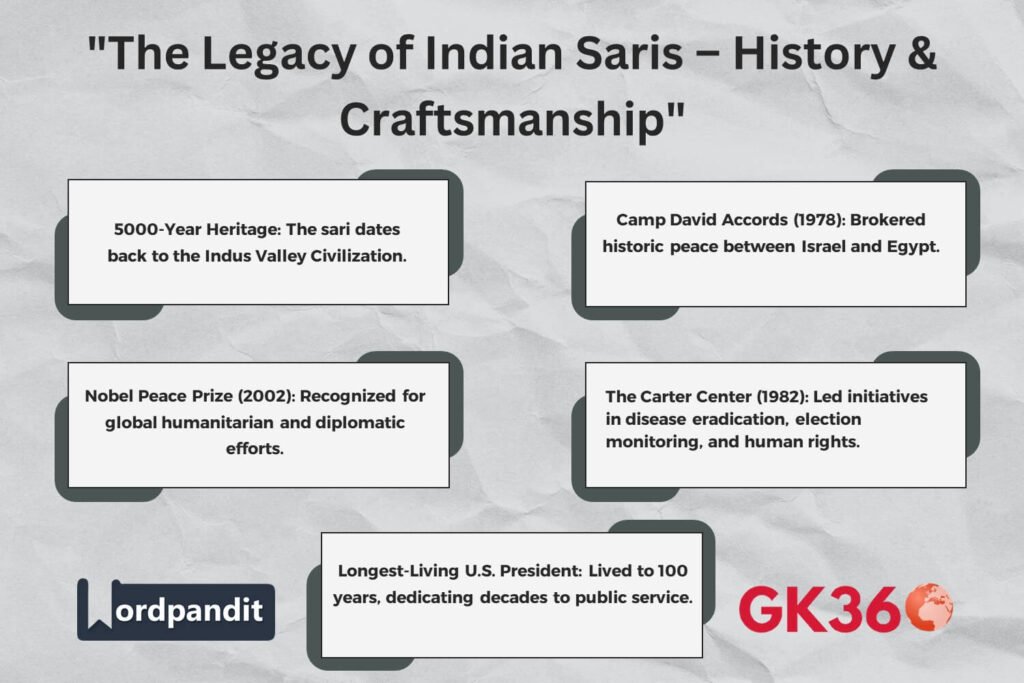Viraasat: Reviving the Legacy of Indian Saris – History, Craftsmanship, and Cultural Significance
Introduction
Indian saris have long been a symbol of elegance, tradition, and cultural pride. From the intricate weaves of Banarasi silk to the understated beauty of Chanderi, each sari tells a unique story of craftsmanship and heritage. The initiative “Viraasat – Weaving the Legacy of Indian Saris” aims to preserve and promote India’s unparalleled textile traditions. This article explores the historical significance, artistry, and cultural relevance of Indian saris, emphasizing why they deserve global recognition.
Table of Contents
- The Timeless Elegance of Indian Saris
- Historical Significance: A 5000-Year Legacy
- The Craftsmanship Behind Sari Weaving
- Cultural and Fashion Influence of Saris
- The Viraasat Initiative: Preserving Handloom Traditions
- Why Indian Saris Deserve Global Recognition
- FAQs
- Conclusion & Call-to-Action
1. The Timeless Elegance of Indian Saris
The sari is more than just a garment; it is a living legacy passed down through generations. Indian saris are woven with tradition, artistry, and an unmistakable charm that transcends fashion trends. Whether worn at weddings, festivals, or everyday occasions, the sari remains a versatile and graceful attire cherished by women across India and beyond.
2. Historical Significance: A 5000-Year Legacy
The origins of the Indian sari trace back over 5,000 years, with its presence evident in sculptures from the Indus Valley Civilization. Over the centuries, regional influences and weaving techniques gave rise to diverse sari styles, such as:
- Banarasi Silk: Renowned for intricate gold and silver zari work.
- Kanjeevaram Silk: Known for its temple-inspired motifs and vibrant hues.
- Bandhani: A traditional tie-and-dye method from Gujarat and Rajasthan.
- Chikankari: Embroidered saris from Lucknow featuring delicate handwork.
These styles reflect India’s rich cultural tapestry, showcasing the nation’s deep connection to textile artistry.
3. The Craftsmanship Behind Sari Weaving
Creating a sari is an intricate process that requires skill, patience, and dedication. The key stages include:
- Weaving: Using traditional handlooms to create stunning patterns.
- Dyeing: Utilizing tie-and-dye or natural dyes for unique color palettes.
- Embroidery: Incorporating detailed handwork, such as zari, mirror work, and beadwork.
- Finishing: Adding final touches like starching and polishing for the perfect drape.
Many artisans inherit their craft through generations, keeping India’s textile heritage alive through their mastery.
4. Cultural and Fashion Influence of Saris
The sari has evolved beyond traditional wear, making its mark in contemporary fashion. Designers worldwide have reinterpreted the sari, blending classic draping styles with modern aesthetics. Bollywood celebrities and global influencers frequently showcase saris on international platforms, further amplifying their appeal.
5. The Viraasat Initiative: Preserving Handloom Traditions
The “Viraasat” initiative plays a crucial role in safeguarding India’s handloom legacy. Key objectives include:
- Educating the public about the significance of handwoven saris through workshops and exhibitions.
- Empowering artisans by providing financial support and global platforms for showcasing their work.
- Promoting sustainability by encouraging the use of eco-friendly materials and traditional dyeing techniques.
Through these efforts, Viraasat ensures that sari weaving continues to thrive in the modern world.
6. Why Indian Saris Deserve Global Recognition
Indian saris embody centuries of tradition, craftsmanship, and sustainable fashion. Unlike fast fashion, saris represent slow, handcrafted artistry that supports local economies. Their versatility makes them suitable for any occasion, making them a treasured piece in wardrobes worldwide.

7. FAQs
Q1: Why are Indian saris considered timeless fashion?
A: Indian saris have been worn for thousands of years and continue to evolve while maintaining their cultural essence.
Q2: What makes Banarasi and Kanjeevaram saris unique?
A: Banarasi saris feature intricate gold and silver zari work, while Kanjeevaram saris are known for their bold colors and temple motifs.
Q3: How does the Viraasat initiative support artisans?
A: It provides financial aid, training programs, and global platforms to help artisans sustain their craft.
Q4: Are handloom saris sustainable?
A: Yes, they are eco-friendly, as they use natural dyes and require minimal industrial processing.
8. Conclusion & Call-to-Action
The sari is more than just a piece of clothing—it is a symbol of India’s rich heritage and artistic brilliance. The “Viraasat” initiative is vital in preserving this legacy and ensuring that handloom traditions continue to flourish. By choosing authentic handwoven saris, we not only celebrate India’s cultural roots but also support the artisans who dedicate their lives to this exquisite craft.
🔹 Discover the beauty of handloom saris and be part of this movement! Explore, appreciate, and wear a piece of India’s legacy.
Key Takeaways Table
| Aspect | Details |
|---|---|
| Historical Significance | The Indian sari has a 5000-year-old legacy dating back to the Indus Valley Civilization. |
| Diverse Styles | Various regional styles like Banarasi, Kanjeevaram, Bandhani, and Chikankari showcase India’s textile richness. |
| Artisan Craftsmanship | Handloom weaving, dyeing, and embroidery techniques are passed down through generations. |
| Sustainability | Handwoven saris use eco-friendly materials and support local artisans. |
| Cultural & Fashion Influence | The sari remains a versatile garment, evolving with modern fashion trends. |
| The Viraasat Initiative | Aims to preserve and promote India’s sari heritage through education and artisan support. |
| Global Recognition | Saris are gaining international appeal through fashion shows and celebrity endorsements. |
Related terms
- Indian Sari History
- Handloom Saris India
- Banarasi and Kanjeevaram Saris
- Sustainable Fashion India
- Traditional Weaving Techniques
- Viraasat Handloom Initiative
- Indian Textiles and Heritage
- Global Influence of Indian Saris
- Sari Fashion Trends
- Artisan Empowerment India






